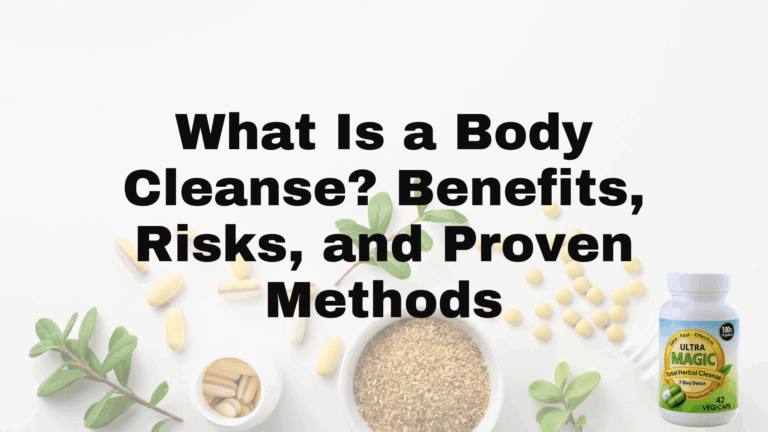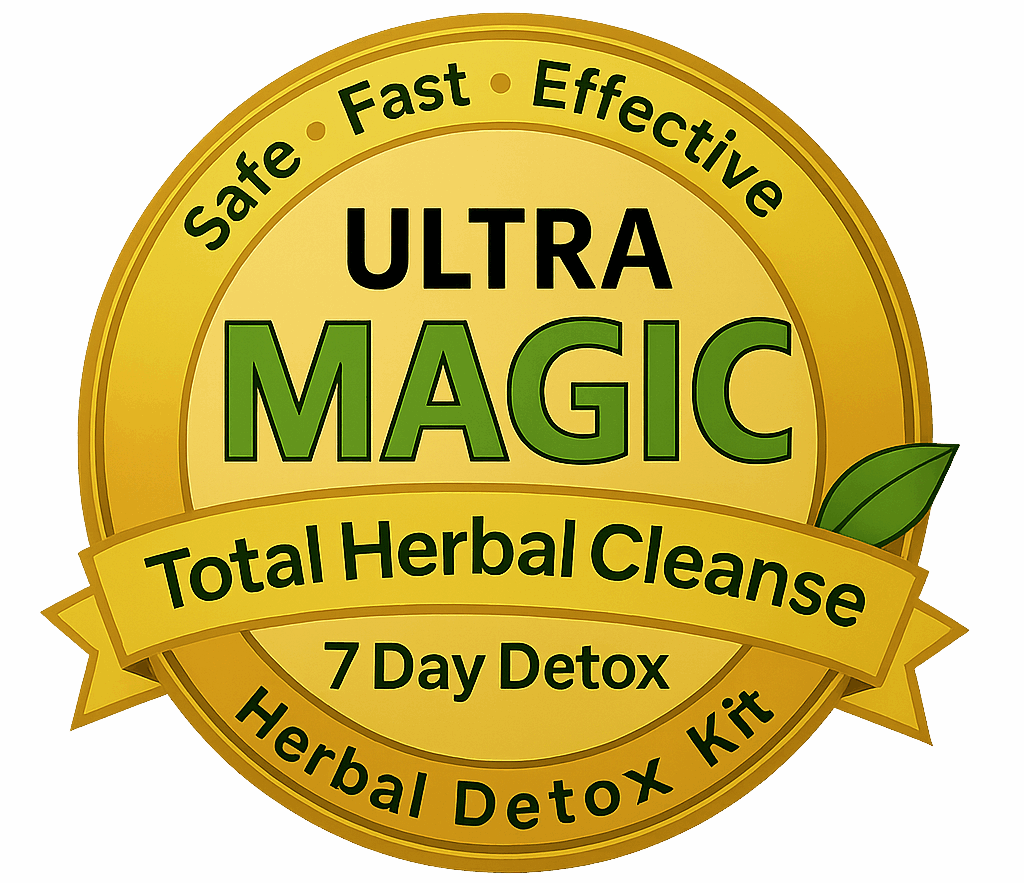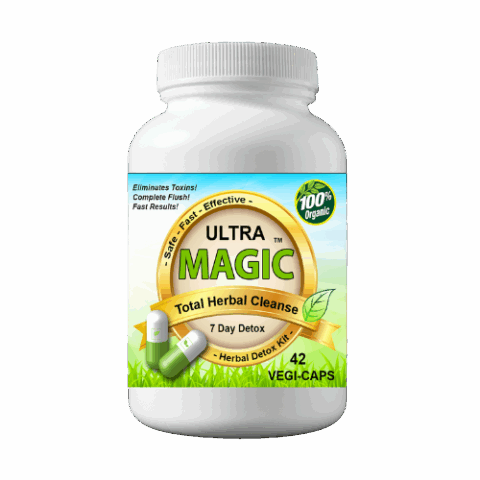
What Is a Body Cleanse? Benefits, Risks, and Proven Methods
A body cleanse is a temporary regimen—dietary, supplemental, or mechanical—intended to speed elimination of built-up toxins and reset digestive and metabolic systems. From three-day juice fasts to week-long herbal kits, the idea promises lighter, cleaner, more energetic living in short order.
Not everyone is convinced. Physicians remind us the liver, kidneys, lungs, skin, and gut already filter waste around the clock, and they question whether pricey cleanses add anything beyond what good nutrition and hydration deliver. Devotees counter with glowing anecdotes of clearer skin, easier movement, and a welcome mental “reset.” Caught between glowing testimonials and skeptical headlines, many readers just want straight answers before deciding what, if anything, to try.
That balance is the aim of this guide. You’ll see what the research says about quick weight loss, toxin removal, and habit change; where risks lurk for certain medications or medical conditions; and how to choose (or skip) a method that fits your goals and timeline. By the end, you’ll have a science-grounded, hype-free roadmap—plus an optional seven-day plan—so you can move forward with confidence.
Body Cleanse vs. Detox vs. Fast: Clearing Up the Terms
Search results often use the words “cleanse,” “detox,” and “fast” interchangeably, but each points to a slightly different tactic—and set of expectations. Knowing which one you’re actually considering prevents disappointment and helps you evaluate safety advice that pops up when you ask “what is a body cleanse” online.
What “Body Cleanse” Traditionally Means
A body cleanse is the modern descendant of ancient purges, now packaged for convenience. It usually lasts 1–10 days and leans on specific products or protocols meant to flush the digestive tract and supporting organs. Common delivery formats include:
- Liquid-only days (juices, broths, nut milks)
- Herbal supplement kits or teas
- Mechanical methods like colonics or salt-water flushes
Because it’s time-limited and product-focused, a cleanse is often marketed as a rapid “reset” rather than a lifestyle overhaul.
How “Detox” Differs in Medical and Wellness Contexts
In clinical medicine, detox means supervised withdrawal from alcohol, opioids, or other drugs—often in a hospital. In the wellness realm, it’s broader: a plan to lower “toxic burden” through diet upgrades, sweat sessions, filtered water, and targeted supplements. Think of it as a multi-pronged spring-cleaning for the whole body, sometimes open-ended rather than date-stamped.
Where Fasting Fits In
Fasting centers on caloric restriction, not specific foods or pills. Popular versions include: intermittent fasting (16:8), 24-hour water fasts, and religious fasts. Although overlapping with cleanses by reducing intake, fasting’s primary goals are metabolic—triggering autophagy, insulin sensitivity, or spiritual focus—rather than explicitly flushing toxins.
Your Body’s Built-In Detoxification Systems
Regardless of the plan you choose, your liver (phase I/II enzymes), kidneys (filtration), GI tract, lungs, skin, and lymphatic network already neutralize and escort waste out daily. The smartest cleanse or detox should support these organs with nutrients, hydration, and rest—not try to “replace” them.
Why People Turn to Body Cleanses
Google’s “people also search for” box tells the story: when stress, holidays, or an unexpected screening pop up, interest in a quick fix spikes. A body cleanse feels like a defined, doable reset—a brief window where habits tighten, menus simplify, and “toxins” supposedly leave the building.
Desired Outcomes and Popular Claims
Most marketing copy circles the same wish list:
- Drop three to five pounds “overnight”
- Beat bloat and clear up skin
- Rekindle energy and focus
- Soothe a sluggish gut or “restart” gut flora
- Sail through an imminent drug test or athletic weigh-in
These promises sit on a spectrum from plausible (better hydration can reduce puffiness) to unverified (permanent toxin removal with one tea).
Psychological Drivers
Beyond biology, a cleanse provides structure and symbolism. Finite rules make healthy behavior feel manageable, and the ritual of mixing juices or taking timed capsules creates a sense of control. For many, it’s less about science and more about drawing a bright line between “before” and “after.”
Real-World Scenarios
- Maya, a 34-year-old project manager, grabs a three-day juice package after a holiday binge leaves her jeans tight.
- Trevor, a collegiate linebacker, uses a seven-day herbal kit to meet off-season weight benchmarks without stimulants.
- Carlos, a warehouse hire, opts for a full-body cleanse when a pre-employment screening lands on his calendar next week.
Different goals, same lure: a fast, tangible reboot that feels more decisive than simply “eating better.”
Potential Benefits: What Evidence Supports (and What Doesn’t)
A quick spin through testimonials makes a body cleanse sound like a magic eraser for every modern woe, from brain fog to belly fat. The evidence tells a more nuanced story. Short-term regimens can deliver measurable improvements in nutrient status and metabolic markers, but the dramatic claims splashed across social media often outpace the data. Below is a reality check so you can separate reasonable expectations from marketing fairy tales.
Benefits with Some Scientific Backing
- Higher micronutrient intake. Juice-based cleanses and produce-heavy plans reliably increase vitamin C, folate, potassium, and an arsenal of polyphenols for the days they’re followed. A small UCLA pilot found antioxidant capacity rose 25 % after a three-day vegetable/fruit cleanse.
- Reduced inflammatory markers. Swapping ultra-processed foods for whole plants lowers C-reactive protein and IL-6 in as little as one week, according to randomized trials on elimination diets.
- Caloric “reset.” Most cleanses hover around 800–1,200 kcal/day, well below typical Western intake. Studies on short energy restriction show transient drops in fasting insulin, glucose, and triglycerides—useful for people flirting with metabolic syndrome.
- Mind–gut focus. Many programs pair fiber, probiotics, or herbal bitters with mindful eating practices, which research links to improved bloating scores and bowel regularity.
Benefits Still Unproven or Overstated
- Permanent toxin removal. Few human studies verify that herbal kits expel measurable amounts of heavy metals, pesticides, or drug metabolites beyond what normal physiology accomplishes. Lab panels often show no lasting difference after two weeks.
- Rapid, sustainable fat loss. Weight lost during a cleanse is mostly water and depleted glycogen; fat oxidation accelerates only slightly at the short durations typically marketed. Without follow-up diet changes, pounds return quickly.
- Cure-all promises. Claims that a 3-day flush treats chronic Lyme, cancer, or autoimmune disease have no credible evidence and may delay necessary care.
Indirect & Behavioral Upsides
Even when biochemical shifts are modest, a structured cleanse can spark healthier habits:
- Hydration shoots up because most plans mandate 8–10 glasses of water or herbal tea daily.
- Sleep often improves when caffeine, alcohol, and late-night snacking are paused.
- Tracking meals and symptoms builds food awareness that carries into regular eating.
- Success in completing a defined protocol boosts self-efficacy, an under-appreciated predictor of long-term lifestyle change.
Bottom line: cleanses can act as a short, motivating bridge toward better nutrition and self-care, but they’re not a scientific shortcut to permanent detoxification or dramatic fat melt. Use them as a springboard, not a silver bullet.
Risks, Side Effects, and When to Avoid a Cleanse
Before you plunk down cash for a kit or load your fridge with green juice, weigh the downsides. Most healthy adults tolerate brief cleanses, but the combination of calorie restriction, diuretic herbs, and electrolyte shifts can backfire—especially if you already have medical issues or you stretch a program beyond its intended length.
Common Short-Term Side Effects
Even gentle protocols can trigger an adjustment period as your body shifts from its usual fuel mix.
- Headaches or “brain fog” from caffeine withdrawal
- Fatigue and irritability when daily calories dip below maintenance
- Bloating, diarrhea, or constipation as fiber or laxative herbs ramp up
- Dizziness from low blood pressure or low sodium
- Muscle cramps linked to potassium or magnesium loss
- Bad breath or metallic taste during ketosis-like states
Most of these symptoms fade within 24–48 hours if you hydrate and rest.
Nutritional & Medical Risks
Longer or more aggressive cleanses magnify the stakes.
- Protein deficit can slow wound healing and strip lean muscle
- Hypoglycemia episodes in diabetics or anyone on insulin/secretagogues
- Worsening kidney function when high-oxalate juices or diuretics pile extra load
- Liver stress from concentrated herbal alkaloids (e.g., cascara, senna)
- Electrolyte imbalance (
Na⁺,K⁺,Cl⁻) leading to irregular heartbeat - Drug interactions—milk thistle can alter warfarin metabolism; grapefruit juices boost statin levels
If you have a chronic condition, clear any cleanse with your physician first.
Who Should Skip or Modify a Cleanse
Certain groups face more risk than reward and should stick with balanced nutrition or medically supervised plans.
- Pregnant or breastfeeding individuals
- Children, teens, and adults over 70
- People with a history of eating disorders
- Type 1 diabetics or poorly controlled Type 2 diabetics
- Those with kidney disease, liver cirrhosis, or gallstones
- Immunocompromised patients (chemotherapy, HIV)
- Anyone on anticoagulants, seizure meds, or lithium
- Athletes in heavy training blocks who need full caloric support
A registered dietitian can tailor safer, food-first tweaks for these populations.
Red-Flag Symptoms That Require Medical Help
Mild discomfort is expected, but certain signs signal real danger. Seek urgent care if you experience:
- Persistent vomiting or inability to keep fluids down
- Severe dizziness, fainting, or vision changes
- Heart palpitations, chest pain, or shortness of breath
- Bloody stools or black, tarry bowel movements
- Sharp abdominal pain that worsens with movement
- Confusion, slurred speech, or sudden weakness
Stopping the cleanse and rehydrating may suffice, but don’t hesitate to call 911 or your local emergency number if symptoms escalate. Listening to your body beats “pushing through” a protocol every time.
Methods of Body Cleansing: From Diet Plans to Herbal Supplements
Cleanses aren’t one-size-fits-all. Some people thrive on nothing but greens and ginger for a weekend, while others prefer a capsule they can swallow with breakfast. Below are the main approaches you’ll see marketed, what each involves, and the practical pros and cons to weigh before committing.
Food-Based Approaches
- Juice or smoothie cleanses
- 3- or 7-day packs built around cold-pressed fruit and veggie blends
- Delivers a surge of vitamins and phytonutrients, but can run 100–150 g of sugar per day and skimp on protein/fiber
- Elimination diets (e.g., Whole30, low-allergen)
- 30 days of whole foods minus alcohol, added sugar, dairy, grains, or legumes
- Helps pinpoint food sensitivities and lowers processed-food load; more balanced macros than liquid cleanses
- Raw or alkaline programs
- Emphasize uncooked produce, sprouted nuts, “alkalizing” mineral water
- High enzyme and fiber intake; cold meals and minimal calories can be hard to sustain in cooler climates or active jobs
Mechanical & Clinical Methods
- Colon hydrotherapy: warm, filtered water introduced rectally to loosen stool. Fans cite bloat relief; GI societies warn of infection, electrolyte loss, and perforation risk.
- Coffee enemas: caffeine solution meant to stimulate bile flow. Limited evidence, plus danger of colitis or burns.
- Saltwater flush: drinking 2 tsp sea salt in 1 qt warm water on an empty stomach. Often produces urgent bowel movements but can spike blood pressure and disturb sodium balance.
Use these only in a licensed clinic with medical oversight—if at all.
Herbal Detox Kits and Supplements
Shelf kits combine laxative, diuretic, and liver-support herbs into timed packets. Reputable formulas share three traits:
- Transparent Supplement Facts (no “proprietary blend” black box)
- Manufactured in GMP or NSF facilities
- Third-party lab tests for heavy metals, microbes, and potency
Common ingredients and their targets:
| Herb | Traditional Role | Typical Concern |
|---|---|---|
| Milk thistle | Liver enzyme support | May alter warfarin levels |
| Dandelion root | Mild diuretic | Potassium loss |
| Burdock root | Lymph & skin health | Rare allergic rash |
| Cascara sagrada | Stimulating laxative | Dependency with long use |
Ultra-Strength Full-Body Herbal Cleanses (e.g., Magic Detox™)
For users with a high toxin load or an impending urine, blood, or saliva test, “maximum strength” kits claim faster, deeper action. Magic Detox™ packs seven certified-organic herbs (Burdock, Dandelion, Rhubarb, Goldenseal, Sheep Sorrel, Cat’s Claw, Pau D’Arco) into easy-swallow capsules taken over seven days. Manufactured in a GMP, FDA-registered Florida facility, it promises permanent cleansing, discreet shipping, and a 30-day money-back guarantee. While customer reviews applaud its potency, the usual caveats apply: follow label directions, hydrate aggressively, and clear any herbal regimen with your healthcare provider—especially if you’re on prescription meds.
Lifestyle-Centered Detox Practices
The least flashy methods often pay the biggest dividends:
- Drink 2–3 L of filtered water daily; add a pinch of salt or a squeeze of citrus for electrolytes.
- Aim for 25–35 g of fiber via vegetables, legumes, chia, and flax to bind bile-based toxins.
- Break a sweat: 30 minutes of brisk walking, cycling, or sauna supports lymph flow and skin elimination.
- Sleep 7–8 hours; phase-II liver enzymes peak overnight.
- Manage stress with breathwork or journaling to curb cortisol-driven cravings that sabotage clean eating.
Blend one or more of these evidence-backed habits with whichever structured plan you choose for a safer, more sustainable cleanse.
Choosing a Safe and Effective Cleanse
Walk down any supplement aisle and you’ll see everything from three-day juice packs to “extreme flush” powders. The abundance of choice can make answering “what is a body cleanse that actually works for me?” feel like guesswork. A quick checklist rooted in science—not slogans—keeps you out of trouble and maximizes results.
Clarify Your Goal and Timeframe
Pinpoint the single outcome you care about most:
- Shed two vacation pounds? A 72-hour produce cleanse may suffice.
- Reduce joint inflammation? Try a 14-day elimination diet.
- Pass a drug screen on short notice? You’ll need a proven, full-body herbal option and at least seven days.
Matching the protocol’s length and intensity to your deadline prevents both disappointment and unnecessary risk.
Investigate Ingredients and Dosage
Flip the bottle or PDF:
- Active herbs and their exact milligrams should be listed—no “proprietary detox matrix.”
- Compare daily totals against research ranges (
milk thistle 150–450 mg,dandelion root 500–1,000 mg). - Scan the “other ingredients” for fillers, artificial dyes, or excessive caffeine.
Check for Independent Certifications
Look for:
- GMP or NSF facility stamps
- Third-party lab reports verifying purity and heavy-metal safety
- Lot numbers for traceability in case of recalls
If you can’t find these on the label or website, keep shopping.
Consult the Right Professional
Bring your chosen product, dosing schedule, and any medications to:
- Primary-care doctor (overall suitability)
- Registered dietitian (nutrient gaps)
- Pharmacist (herb–drug interactions)
A 10-minute review now beats an ER visit later.
Spotting Scams and Unrealistic Claims
Red flags include:
- “Lose 20 lbs in 3 days” or “detox while eating junk food”
- No refund policy or a mailbox-only contact address
- Stock photos masquerading as before-and-after shots
- Pressure to buy multiple “booster” add-ons
When in doubt, step back, reread the fine print, and remember: a legitimate cleanse supports your body’s detox organs—it doesn’t replace common sense.
A Balanced 7-Day Cleanse Plan You Can Follow at Home
The following template is meant for generally healthy adults who want a gentle reset without extreme calorie cuts or expensive deliveries. It combines fiber-rich meals, strategic supplementation, and daily self-care so the liver, kidneys, and gut have everything they need to do their job. Adjust portions for your size and activity level, and clear the plan with a healthcare professional if you take medication or have a chronic condition.
Pre-Cleanse Preparation (Day -2 to Day 0)
Two quiet days of “cleaning the slate” make the actual cleanse far easier.
- Taper coffee or energy drinks to avoid withdrawal headaches.
- Eliminate alcohol, fried foods, and added sugar.
- Stock up on staples: leafy greens, berries, citrus, cucumbers, avocados, lentils, quinoa, bone or veggie broth, herbal tea, lemons, sea salt, and optional herbal capsules (e.g., Magic Detox™).
- Aim for 7–8 hours of sleep and light movement (walking, stretching) to prime digestion.
Daily Schedule Overview (Day 1–Day 7)
| Time | Action | Why It Helps |
|---|---|---|
| 7 am | 12 oz warm water + juice of ½ lemon | Rehydrates, triggers bile flow |
| 7:30 am | Gentle mobility or 15 min yoga | Stimulates lymphatic drainage |
| 8 am | Breakfast smoothie: spinach, frozen berries, 1 Tbsp flax, unsweetened almond milk, scoop plant protein (≈300 kcal) | Antioxidants, fiber, amino acids |
| 10 am | 16 oz water or herbal tea | Maintains kidney filtration |
| Noon | Rainbow salad + ¾ cup lentils + olive-oil vinaigrette (≈450 kcal) + optional herbal capsules | Fiber binds toxins; herbs support liver |
| 2 pm | 10-minute walk, sunlight exposure | Aids circadian rhythm |
| 3 pm | Snack: apple slices with 2 Tbsp almond butter (≈200 kcal) | Stable blood sugar |
| 6 pm | Dinner soup: broth, quinoa, kale, carrots, turmeric, black pepper (≈400 kcal) | Easy to digest, anti-inflammatory |
| 8 pm | Digital wind-down; journaling feelings/cravings | Reinforces mindful eating |
| 9:30 pm | Lights out | Sleep is prime detox time |
Daily targets:
- Calories: 1,000–1,400 depending on needs
- Water: 8–10 glasses (add pinch of sea salt to two of them for electrolytes)
- Movement: 30 min light cardio or sauna session
- Supplements: probiotic (AM) + magnesium glycinate (PM) for bowel regularity
Post-Cleanse Reintroduction and Maintenance
Day 8–Day 14 is about stabilizing, not celebrating with junk food.
- Reintroduce lean proteins (eggs, chicken, tempeh) at one meal per day, watching for bloating or fatigue.
- Bring back complex carbs—oats, sweet potatoes, brown rice—slowly, ½ cup at a time.
- Continue hydration and the lemon-water morning ritual.
- Schedule a weekly “mini-reset”: 12-hour overnight fast, meat-free Monday, or a sauna session to keep momentum.
- Reflect on which cleanse habits felt natural; lock those into your regular routine to extend benefits long after the seven days are over.
Frequently Asked Questions About Body Cleansing
Below are quick, research-backed answers to the questions that pop up most often when people type “what is a body cleanse” into Google. Use them as reality checks before you buy another jug of celery juice or an herbal megadose.
What Actually Leaves Your Body During a Cleanse?
Mostly ordinary waste: water, sodium, glycogen, and stool. A short cleanse can speed bowel movements and increase urine output, which makes you feel “lighter.” Laboratory data show only trace shifts in stored pesticides or heavy metals after a week; your liver and kidneys continue to handle the bulk of that work, cleanse or not.
Can You Flush Your Whole Body in 24 Hours?
Not really. Hydrating well, eating potassium-rich produce, and skipping alcohol can improve fluid balance in a single day, but deeper processes—like up-regulating liver phase-II enzymes—take several days of consistent nutrients and rest. Any product promising a complete toxin purge overnight is marketing, not physiology.
Is Weight Lost on a Cleanse Fat or Water?
Mostly water and depleted glycogen. Each gram of stored carbohydrate binds roughly 3–4 g of water, so lower carb intake releases a quick couple of pounds. True fat loss requires a longer calorie deficit combined with protein and resistance work to preserve muscle. Expect to regain some scale weight once normal eating resumes.
How Is a Drug Detox Different From a General Cleanse?
Medical drug detox is a supervised protocol that manages withdrawal symptoms and prevents complications when coming off alcohol, opioids, or similar substances. A consumer “body cleanse,” by contrast, is an over-the-counter regimen aimed at digestive or metabolic refresh. If you need to eliminate drug metabolites for a legal or employment test, you’re still essentially doing a targeted cleanse, but you should choose a proven, full-body formula and consult a healthcare professional for safety.
Bottom Line on Body Cleanses
A well-planned body cleanse can be a helpful, short-term nudge toward better habits—reminding you to hydrate, eat more plants, and give your digestive system a rest. Research shows modest, temporary gains like lower inflammatory markers, improved insulin response, and a mental “fresh start.” Still, your liver, kidneys, lungs, and skin already handle detoxification daily, so promises of complete toxin removal or effortless fat melting don’t match the science and can even turn dangerous if a protocol is extreme or misused.
If you’re healthy and curious, keep any cleanse brief (under 7–10 days), emphasize whole foods over gimmicks, and watch for red-flag symptoms such as severe dizziness, heart palpitations, or relentless GI distress—signals to stop and seek medical advice. Pregnant or breastfeeding individuals, minors, and people with chronic conditions are better served by personalized nutrition guidance, not off-the-shelf cleanses.
Need a stronger, targeted option for a looming drug screen or heavy toxin load? A rigorously tested herbal formula like Magic Detox™ may fit the bill—just clear it with your healthcare provider first. For details, visit the Magic Detox™ homepage.



